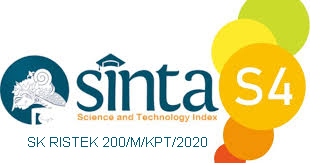Expert System for Diagnosing Covid-19 Disease Using Method Forward Chaining
Abstract
December 2019 was the beginning of cases that hit the Wuhan area, increasing cases of Covid-19 in China every day and increasing from January to February 2020. Initially reports came from the Hubei area and surrounding provinces, and the reports that came increased to the provinces around China, there were 86 other cases reported from various parts of the country, including Indonesia. Indonesia's first Covid-19 disease reportedly entered on March 2, 2020, there were two cases. The latest information is published on the official WHO website (World Health Organization) it was recorded that from January 3, 2020 to March 18, 2022 in Indonesia, there were 5,948,610 people who were recorded as positive for Covid-19 and 153,411 people were confirmed to have died. Diagnosing Covid-19 is the job of experts or specialists who have experience and knowledge in this field. An alternative that can help people who are not experts in diagnosing Covid-19 is an expert system. The forward chaining method was chosen because it is a forward tracking technique that is sorted according to the number of facts and ends with a conclusion. Forward Chaining is a method inference engine where this method compares facts and statements and will start from the left first (IF). Where, reasoning will start from the facts and then test the validation of the hypothesis (THEN). This research was conducted to make it easier for non-experts to diagnose Covid-19 with this expert system, and to be able to provide solutions after a successful diagnosis.
Keywords
Full Text:
PDFReferences
A. Susilo et al., "Coronavirus disease 2019: Tinjauan literatur terkini," Jurnal penyakit dalam Indonesia, vol. 7, no. 1, 2020.
W. H. Organization, "Coronavirus disease (COVID-19), 12 October 2020," 2020.
R. Khaerunnisa, N. A. Rumana, N. Yulia, and P. Fannya, "Gambaran Karakteristik Pasien Covid-19 di Rumah Sakit Mekar Sari Bekasi Tahun 2020-2021," Jurnal Manajemen Informasi Kesehatan Indonesia, vol. 10, no. 1, pp. 72-72, 2022.
H. Pratiwi, Buku Ajar: Sistem Pakar. Goresan Pena, 2019.
B. H. Hayadi, Sistem pakar. Deepublish, 2018.
R. Rizky, A. H. Wibowo, Z. Hakim, and L. Sujai, "Sistem Pakar Diagnosis Kerusakan Jaringan Local Area Network (LAN) Menggunakan Metode Forward Chaining," Jutis (Jurnal Teknik Informatika), vol. 7, no. 2, pp. 145-152, 2019.
F. Kesumaningtyas, "Sistem Pakar Diagnosa Penyakit Demensia Menggunakan Metode Forward Chaining Studi Kasus (Di Rumah Sakit Umum Daerah Padang Panjang)," Jurnal Edik Informatika Penelitian Bidang Komputer Sains dan Pendidikan Informatika, vol. 3, no. 2, pp. 95-102, 2017.
N. Rubiati and R. Kurniawan, "SISTEM PAKAR DIAGNOSA PENYAKIT MATA MENGUNAKAN METODE FORWARD CHAINING," Lentera Dumai, vol. 12, no. 2, 2021.
M. Sari, S. Defit, and G. W. Nurcahyo, "Sistem Pakar Deteksi Penyakit pada Anak Menggunakan Metode Forward Chaining," Jurnal Sistim Informasi Dan Teknologi, pp. 130-135, 2020.
M. B. Priyantono, A. A. Rachmawan, L. A. P. Budi, and K. C. Kirana, "Sistem Prediksi Gejala Virus Korona dengan Metode Forward Chaining," JTERA (Jurnal Teknologi Rekayasa), vol. 5, no. 1, pp. 111-118, 2020.
A. P. Gusman, D. Maulida, and E. Rianti, "Sistem Pakar Diagnosa Penyakit Kista Ovarium Dengan Metode Forward Chaining," Jurnal KomtekInfo, vol. 6, no. 1, pp. 8-18, 2019.
R. E. Putri, K. M. Morita, and Y. Yusman, "Penerapan Metode Forward Chaining Pada Sistem Pakar Untuk Mengetahui Kepribadian Seseorang," INTECOMS: Journal of Information Technology and Computer Science, vol. 3, no. 1, pp. 60-66, 2020.
M. Irawan, A. Widarma, Y. Siregar, and R. Rudi, "Penerapan Metode Forward-Backward Chaining pada Sistem Pakar Pencegahan dan Pengobatan Penyakit Sapi," Jurnal Teknologi dan Informasi, vol. 11, no. 1, pp. 14-25, 2021.
I. Akil, "Analisa efektifitas metode forward chaining dan backward chaining pada sistem pakar," Jurnal Pilar Nusa Mandiri, vol. 13, no. 1, pp. 35-42, 2017.
R. R. Girsang and H. Fahmi, "Sistem Pakar Mendiagnosa Penyakit Mata Katarak Dengan Metode Certainty Factor Berbasis Web," MATICS: Jurnal Ilmu Komputer dan Teknologi Informasi (Journal of Computer Science and Information Technology), vol. 11, no. 1, pp. 27-31, 2019.
F. C. Ningrum, D. Suherman, S. Aryanti, H. A. Prasetya, and A. Saifudin, "Pengujian black box pada aplikasi sistem seleksi sales terbaik menggunakan teknik equivalence partitions," Jurnal Informatika Universitas Pamulang, vol. 4, no. 4, pp. 125-130, 2019.
A. Rizaldi, A. Voutama, and S. Susilawati, "Sistem Pendukung Keputusan Menggunakan Certainty Factor Dalam Mendiagnosa Kategori Tingkat Demam Berdarah," Generation Journal, vol. 5, no. 2, pp. 91-101, 2021.
P. Krause, D. Clark, P. Krause, and D. Clark, "The Certainty Factor Model," Representing Uncertain Knowledge: An Artificial Intelligence Approach, pp. 52-67, 1993.
DOI: https://doi.org/10.31326/jisa.v7i1.1786
Refbacks
- There are currently no refbacks.
Copyright (c) 2024 Sofiansyah Fadli, Maulana Ashari, Ria Septi Wahyuni, Saikin, Didik Sudyana

This work is licensed under a Creative Commons Attribution-ShareAlike 4.0 International License.
JOURNAL IDENTITY
Journal Name: JISA (Jurnal Informatika dan Sains)
e-ISSN: 2614-8404, p-ISSN: 2776-3234
Publisher: Program Studi Teknik Informatika Universitas Trilogi
Publication Schedule: June and December
Language: English
APC: The Journal Charges Fees for Publishing
Indexing: EBSCO , DOAJ, Google Scholar, Arsip Relawan Jurnal Indonesia, Directory of Research Journals Indexing, Index Copernicus International, PKP Index, Science and Technology Index (SINTA, S4) , Garuda Index
OAI address: http://trilogi.ac.id/journal/ks/index.php/JISA/oai
Contact: jisa@trilogi.ac.id
Sponsored by: DOI – Digital Object Identifier Crossref, Universitas Trilogi
In Collaboration With: Indonesian Artificial Intelligent Ecosystem(IAIE), Relawan Jurnal Indonesia, Jurnal Teknologi dan Sistem Komputer (JTSiskom)
JISA (Jurnal Informatika dan Sains) is Published by Program Studi Teknik Informatika, Universitas Trilogi under Creative Commons Attribution-ShareAlike 4.0 International License.


















